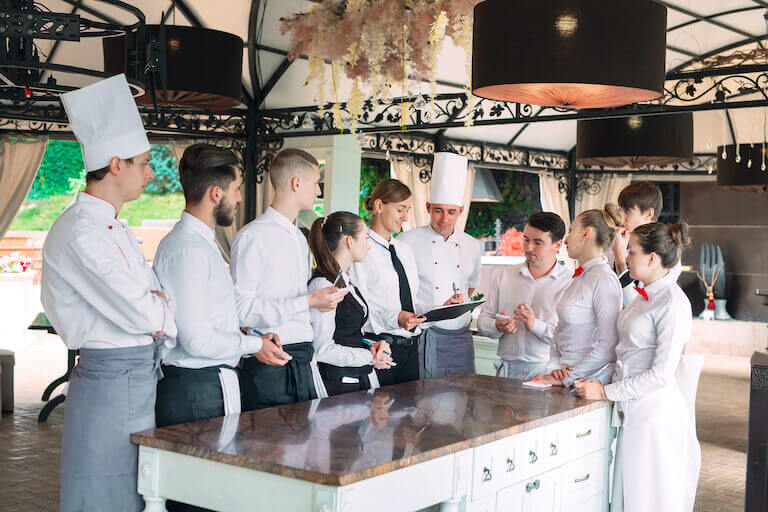Envision the best job you’ve ever had. What stands out to you?
It likely isn’t simply limited to the work you did, but rather to the people and atmosphere you were surrounded by. And if that’s the case, you enjoyed this job because of the company culture.
Now, as a restaurant owner, you’re running the show. This means you can provide a great work environment for your team by creating a positive team culture in your restaurant.
What Is “Company Culture” and Why Should You Care?
Simply put, the culture of the company encompasses what people think, say, and do in an organization. It’s the overall “vibe” or how someone would describe the personality of your business if it were a person. You don’t have to try to have a culture, just like you don’t have to try to have a personality. It’s inherent in existing.
A strong, positive culture fosters a sense of identity and belonging among employees, which can lead to increased motivation, productivity, and a lower turnover rate. It’s not just about creating a pleasant work environment; it’s about building a foundation that supports the company’s goals and drives success.
A company’s culture is shaped by a variety of factors – leadership styles, communication patterns, organizational structure, and even the physical workspace. It’s dynamic and evolves over time, influenced by the people who are part of the company and the external environment. Understanding and nurturing this culture is essential for any leader who aims to create an organization where people feel valued, their work is meaningful, and their contributions drive the company forward.

Your company culture should bring everyone closer together so they operate well within their roles.
A Strong Team Culture Benefits Everyone
The core of a restaurant’s success is satisfied customers. And where does that satisfaction come from? Happy employees who deliver excellent customer service. Employees who enjoy the work they do create a better experience for customers, which in turn creates better reviews and overall reputation. Best of all, that strong community perception will encourage more to come to your restaurant, bringing you even more revenue.
Company culture impacts the productivity, creativity, and emotional investment of employees. Teamwork, collaboration, and connection directly correlate to how much a person enjoys their work.
The best companies attract the best employees, and top-tier talent doesn’t settle for less than the best company culture. If you raise your bar, the bar of your team will follow.
Signs of Culture Creation Success
Knowing whether you’re hitting the nail on the head doesn’t have to be a shot in the dark. Signs of a positive company culture include:
- Low turnover
- Regular leadership reviews that promote open communication
- Peer reviews to minimize office politics
- High number of job applicants
Determine what metrics are most important to you, and begin tracking them. Establish a baseline measurement first by documenting the numbers for where you currently stand. Periodically update the data and watch your restaurant flourish as you implement new efforts.
Develop a Mission Statement and Core Values to Serve as Your North Star
Before you can ever hope to communicate the culture to your team, you need to have a clear understanding of what you hope to accomplish and how. This begins with establishing a mission and a vision for your company.
A few questions to consider as you determine your future trajectory include:
- What type of impact do you hope to have both internally within your restaurant and externally with customer experience?
- How will you set yourself apart from the culinary crowd?
- Do you value a culture that is professional and polished or more casual and laid back?
- On a day-to-day basis, what activities are performed and by whom?
Additionally, you’ll want to identify core values to help everyone align on how to actually execute the mission and vision properly. During this process, identify what you will do differently and what sets you apart from competitors. Finally, establish both long- and short-term goals to help you make these objectives a reality.
Build a Business Foundation that Supports Your Employees’ Growth
Once you know what you want to accomplish and how, you can begin building the guidelines and parameters that will make it a reality. This includes everything on the back-end of business, from job titles and responsibilities to standard processes and policies.
Provide Structure for the Organizational as a Whole
Kitchens can be chaotic. As the owner, you can structure that chaos by understanding the hierarchy of your restaurant and the scope of each position within it. Before you can articulate this to your employees, map out each role. Specify what they do, what they are responsible for, and whom they report to. In a professional kitchen the brigade de cuisine is the most clear-cut example of a well-defined and efficient hierarchy.
When each team member knows their responsibilities and understands how they all work together as a whole to achieve success, it ingrains a team spirit in them that an environment of unstructured chaos could destroy. You’ll have fostered camaraderie by implementing a structure that can also help ensure better performance for your restaurant.
And to keep things running smoothly enough that your employees don’t get frustrated, you can note where cross-training exists, so you don’t have to ask anyone to perform tasks that are foreign to them.

Investing time and energy into building a good business foundation makes a positive work culture natural.
Communicate Expectations Through Policies
There is no such thing as over-communication when it comes to expectations. The more you can inform and educate your employees on what you need, the better equipped they are to deliver. You can create this understanding from the beginning with proper policies such as a dress code, code of conduct, and company handbook. Requiring every employee to sign and agree to abide by policies also provides a reference if behavioral adjustments are needed in the future.
Offer Competitive Incentives
Positive work culture isn’t a one-way street where companies can make demands of employees without offering anything in return. It’s important to bring something of value to the table and create a mutually beneficial relationship. Understand that these benefits are an investment in your staff. As you support them, you’re also creating trust and loyalty, which can add to the positivity of your team culture.
What this looks like may vary from company to company, but a few common benefits include:
- Work-life balance, paid time off, and schedule flexibility
- Good insurance options
- Personal development, professional growth, and networking opportunities
- Great wages
You can also get creative with other perks you can offer that employees actually need or want. This could include English lessons for first-generation immigrants, transportation to work, a childcare stipend for parents, or meals on-site. Whatever benefits you decide to include, market them well when hiring to appeal to more candidates and improve their work-life balance. When you staff your restaurant with people who feel supported, they’re more likely to support one another, which can improve efficiency, reduce turnover, and build camaraderie.
Where to Find the Right Personnel
All the hard work you do to develop a positive team culture will be for naught if you don’t also build a team that supports it. Finding the right person for the right role who also aligns with your company values can be a challenge, but it’s certainly worth the effort.
As you hire, clearly define what you’re looking for and look in the right places. Take your time in the hiring process and cut your losses once you notice someone is the wrong fit. This will reduce turnover and the costs associated with it.
If you’re looking to expand your applicant pool, expand the places you are looking. Are there untapped avenues like apprenticeship and internship or externship programs or scholastic connections? Post job listings where your ideal employee is likely to find them. As you interview applicants, bring questions to the conversation that will allow you to gauge if they will fit within your company culture and bring positivity with them.
Most importantly, model the culture yourself. As you lead by example, you’ll connect with those who can match it.

Fill your team with individuals who fit well within your culture.
Lean on Expert Guidance
While building a positive team culture takes work, there’s no doubt that it can pay dividends and can make your life easier as a business owner. But there are a lot of nuances involved in personnel management and other aspects of the industry that can be overwhelming if you’re not prepared for them.
A culinary education, which can include business-oriented classes when received at Escoffier, could be the thing that makes you the kind of business owner a team wants to work for. Escoffier’s Food Entrepreneurship and Hospitality & Restaurant Operations Management programs are excellent places to start.
Financial aid is available for those who apply and qualify, so enrolling in culinary school doesn’t just have to be a far-off dream. You can make it happen, and we’re here to answer your questions.





